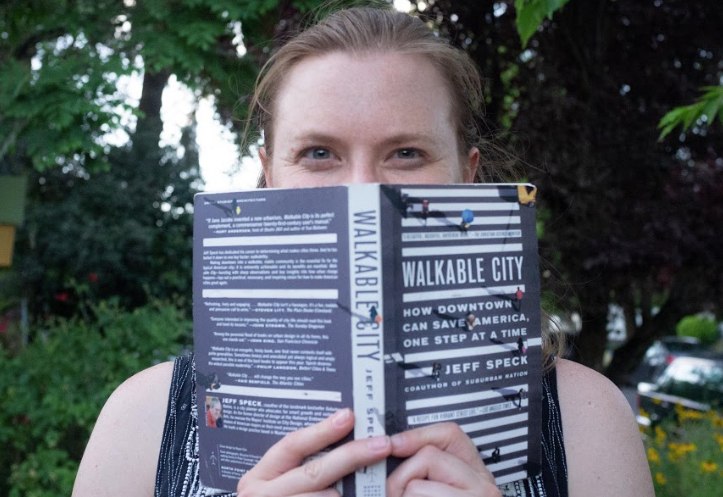
(Photo: Catie Gould)
This summer reading list was created by Catie Gould and Emily Guise, BikeLoud PDX volunteers and co-editors of our Adventures in Activism column.
Summer is a great time to relax by the pool (fountain, river, lake, sprinkler, or whatever) and still get nerdy about transportation and land-use. What could be better?
Here’s our list of favorite urbanist classics and a few newer ones for good measure…
Geography of Nowhere, by James Howard Kunstler
Why are the suburbs so awful? Kunstler holds no punches, decrying cookie cutter strip malls and cartoon architecture as the “greatest misallocation of resources the world has ever known”. From the first American suburb to now, get a thorough history lesson on how things went so awry and envision how to restore civic life in these forsaken places. For a teaser, check out his fiery TED talk.
The Color of Law, by Richard Rothstein
From one development project to the next, the slow march through our historical segregation through official mortgage lending, zoning, and housing programs is going to change how you see your neighborhood forever. Which is a good thing, because it very likely has a racist history that still affects people today. Power through the feeling of being punched in the heart to the end where we look forward to what’s next for housing justice.
Street Fight, by Janette Sadik-Khan
Ted Wheeler asked in a recent Vision Zero briefing why New York City is making more progress than us. The answer is here: strong political leadership. Former NYC Transportation Commissioner Sadik-Khan walks us through her BetterBlock-style street transformation projects and dealing with the public backlash in the process. If you work at PBOT or City Hall, or criticize people who do, this is a must read.
Advertisement
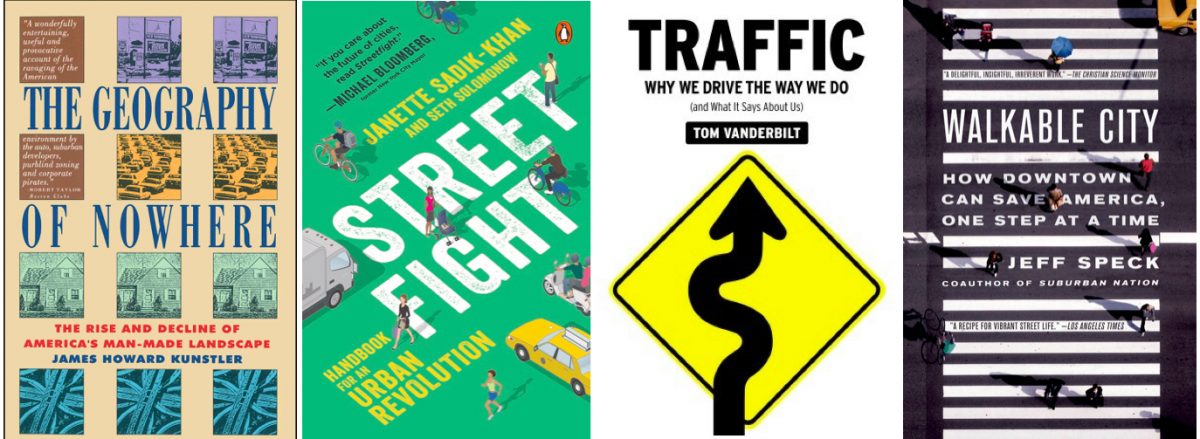
Walkable City, by Jeff Speck
Walkers are an indicator species of a good street, and details matter a lot. Speck thoroughly examining every aspect of walkability, from one way vs two way streets, to parking pricing, to the ROI on street trees. Loaded with details, this book is not just an enjoyable read but a comprehensive guide for fixes to improve walkability that you’ll want to revisit again and again. Read with a pen handy.
Traffic: Why We Drive the Way We Do, by Tom Vanderbilt
A thorough look at the history, economics, psychology, and more of traffic and how this seemingly innocuous, mundane activity actually has huge implications for our mental and physical well-being, our wallets, and our economy. You won’t be able to think about traffic the same way after reading this one- especially the very compelling argument for the ‘late merge’ technique.
Bikenomics: How Bicycling Can Save the Economy, by Elly Blue
A concise argument in book form for why and how bicycling can kickstart local economies through boosting development and growth, and strengthen local communities by offering the freedom of a viable, non-car transportation option. Written by local bike luminary (and former BikePortland editor) Elly Blue.
The Death and Life of Great American Cities, by Jane Jacobs
One of the indispensable pillars of the new urbanist movements, Jacobs was a noted community organizer whose timeless observations of street life-her famous ‘sidewalk ballet’-are backed up by serious research and with an easy-to-read style courtesy of her journalistic background. This was her first book and it should be on every advocate’s shelf.
Happy City, by Charles Montgomery
Our physical environment shapes everything: From how much we trust our neighbors, to how many friends you have. What roles does architecture play? Or public transit? When our cities are at their best, so are their residents who live in them. Loaded with studies on the science of happiness and urban design examples, you’ll be sure to learn a lot of great facts sure to impress your non-transportation friends at parties.
In the City of Bikes: the Story of the Amsterdam Cyclist, by Pete Jordan
Former Portlander Jordan provides a fascinating look at cycling in the cyclists’ city, Amsterdam, from its beginnings in the 1890s, to the critical political street space protests and political action of the 1970s, to the continually evolving bike infrastructure of today.
Bleeding Albina: A History of Community Disinvestment, 1940-2000, by Karen J. Gibson
A sobering, but very necessary history of the Portland neighborhoods of inner North and Northeast. It explains how redlining, predatory lending, highway building, housing speculation borne of discrimination against Portland’s small Black community led a once thriving area to become a ghetto. It also examines how in the 1990s, low housing prices and neighborhood reinvestment opportunities quickly gentrified the neighborhoods while displacing long-time residents. A must read for anyone living in Portland.
— Catie Gould (@Citizen_Cate) and Emily Guise (@EGuise)
Never miss a story. Sign-up for the daily BP Headlines email.
BikePortland needs your support.

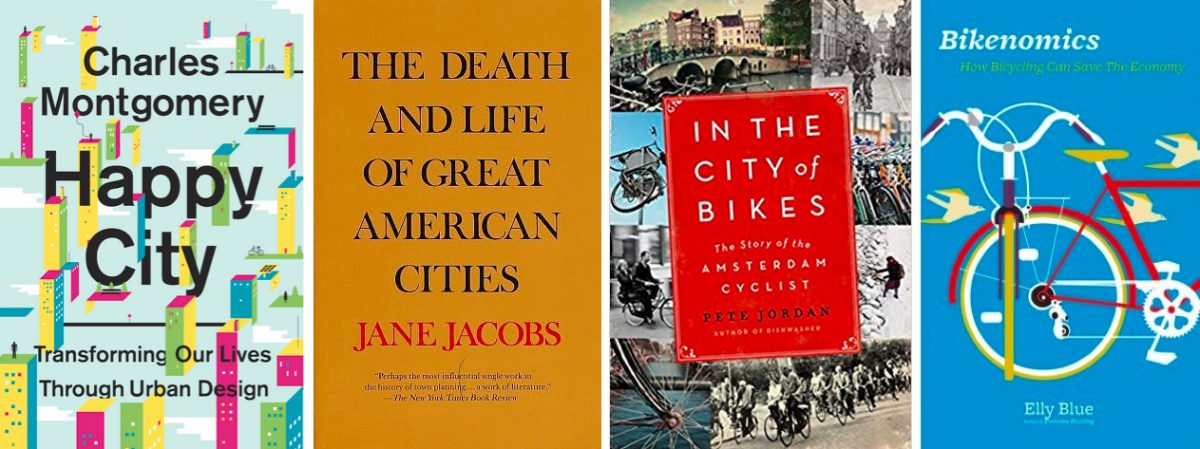
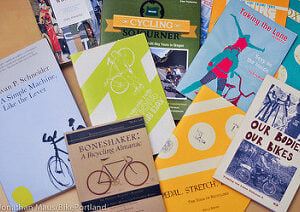

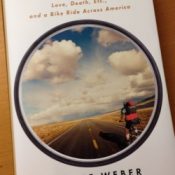

Thanks for reading.
BikePortland has served this community with independent community journalism since 2005. We rely on subscriptions from readers like you to survive. Your financial support is vital in keeping this valuable resource alive and well.
Please subscribe today to strengthen and expand our work.
Good list. I would add Bicycle Diaries by David Byrne.
Great list!
For your consideration: Peter Norton is a great historian on the history of car culture in the US. He gave a great keynote at NACTO last year that I found on YouTube: https://www.youtube.com/watch?v=Iiv5vOBb6Aw.
His book “Fighting Traffic” is on my reading list:
http://www.powells.com/book/-9780262516129
I read Fighting Traffic. there’s a lot of great information in there, but I think a heavier hand on the part of an editor would have improved it dramatically.
Radical Markets, Uprooting Property and Democracy for a Just Society, by Eric A Posner and E Glen Weyl
I would also recommend, what I regard, as the granddaddy of new urbanist guides as well as one of the most important books written in the last 50 years :
“The Pattern Language” by Christopher Alexander. ISBN 0-19-501919-9
To drill down to our problems with the automobile on a deeper level I would recommend
Ivan Illich’s book, ” Tools for conviviality” where he first uses the term “radical monopoly” to describe technologies like the automobile that make alternative methods or technologies nearly impossible.
Excellent post.
I’d add The Power Broker by Robert Caro. The High Cost of Free Parking by Shoup (and perhaps Parking in the City). Fire at Eden’s Gate by Brent Walth. Evicted by Matthew Desmond.
Some good ones there. I definitely second Geography of Nowhere (despite occasional tangents complaining about the ugliness of car oriented development when the real problem is its functional deficiencies) and Traffic.
I might also have to check out Walkable City after seeing this list.
Additionally, I would recommend Pedaling Revolution by Portland’s own Jeff Mapes. There were some great “aha!” insights for me in there.
Happy to see “The Geography of Nowhere” listed here. Can’t begin to say how much this book changed me when reading it in the mid 90’s. I’ve never looked at the built American landscape the same since; it gave me an entirely new way of seeing. Have bought it many times as gift for others. Worth mentioning the sequel to it, “Home From Nowhere” as well as another follow up “The City in Mind” Kunstler is also a novelist, and part of his strength lies in a writing style full of black humor and a story telling narrative lacking in much academic and non-fiction reading. You will equally learn and be amused! Hard to believe it was written 25 years ago; Kunstler was way ahead of his time. (though not as much as Jacobs 😉
I have no problem with Jacobs’ opposition to freeways and concrete urban deserts but I find the juxtaposition of “Color of Law” and “The Death and Life of Great American Cities” to be ironic. IMO, Jacobs’ obsession with preserving neighborhoods and encouraging bourgeoisie renewal (e.g. “good gentrification”) served as one of the main inspirations for the waves of economic redlining and displacement that decimated diverse urban neighborhoods.
Moskowitz’s sympathetic critique highlights the inevitable outcome of this kind of renewal:
“Seemingly every Jacobsian paradise, from Portland, Oregon, to San Francisco to the newly revitalized parts of Detroit and New Orleans, is mostly white and well-off.”
http://www.slate.com/articles/business/metropolis/2016/05/happy_100th_birthday_jane_jacobs_it_s_time_to_stop_deifying_you.html
And, for me, this quote epitomizes Jacobs’ influence on Portland politics:
“The people who move to gentrifying areas tend to have liberal, tolerant, cosmopolitan sympathies. But they are aligned materially with reactionary and oppressive city restructuring, pushing them into antagonism with established residents, who do nothing for property values. Behind every Jane Jacobs [Vera Katz] comes Rudy Giuliani [Hales and Wheeler] with his nightstick.”
https://www.jacobinmag.com/2014/09/liberalism-and-gentrification/
When I first read The Life and Death of American Cities I also found myself asking questions about gentrification that were not touched on her book. I think the two make a great pairing.
I don’t think it’s fair or accurate to saddle Jacobs “as one of the main inspirations for the waves of economic redlining and displacement that decimated diverse urban neighborhoods.” First of all, redlining and segregation long preceded her time. And in making neighborhoods walkable and livable without a car, her efforts have done much to save American cities. If our cultural prejudices, racial fears and capitulation to the wishes of developers and other private interests allow unjust and oppressive forces to gain control it’s hardly the fault of those with a vision to make cities fit for human habitation and establish a meaningful quality of life in them! If anything Jacobs courageous stand in 1950’s and 60’s New York was precisely the opposite! She stood alone at first against a great villain of mid-century America, Robert Moses, who wanted to and largely did eviscerate the hearts of countless wonderful ethnic communities across the nation. All done for the Federal Interstate program in order to facilitate white suburbanites flight to the suburbs while allowing “easy” assess to the city with their cars. Dozens of American cities have yet to recover from this, and some likely never will. Eisenhower, the force behind the Interstate system did not even imagine it going into, much less obliterating swathes of the urban fabric. Moses is possibly the most unrecognized force for malevolence and destruction in 20th century America. You greatly misread history here and use only the lens of present conditions and project it backwards, so distort the course of events.
instead of retreating to an historical debate you might attempt to address criticism of jacobs’ legacy in the present day. (also, the idea that i’m in any way a defender of moses’ car culture is not even worth addressing.)
“it’s hardly the fault of those with a vision”
the problem is that this vision benefited wealthier white people and displaced existing residents, again, and again, and again.
it’s not as if there is much debate about what happens to housing costs when one emphasizes quaint “neighborhood character” and urban renewal via incentivization (shamefully, often via direct subsidy) of cafes, restaurants, bars, boutiques, garden/home furnishing stores, yoga shalas, doggie day care centers etc.
as moskowitz put it:
First off, no one implied you were defending Moses so no need to get defense that you were. And looking at historical context is not a “retreat” – it’s reality. Fashionable nowadays to try figures of past eras with present day criteria as you attempt with Jacobs here. But hardly useful to really judge. And this is done very selectively of course. I’ve yet to see a revisionist take like yours on say, Caesar Chavez, who was very strongly against undocumented immigration. He reasoned that a flood of legally powerless and vulnerable workers in the US would undermine any attempt to unionize workers and raise their standard of living . I won’t go into the pros and cons of that argument, only to show that even on the left we have sacred cows that we don’t want to knock off pedestals. Any and all figures in the past judged by the present will be found wanting in some way and this is shooting fish in a barrel and unworthy of us. Ironically your quote makes my argument:
“Dense, pedestrian-friendly spaces don’t have to be accessible only to the affluent, of course. But without commitments to affordable and public housing and even the regulation of rent, any change to a neighborhood that increases its real-estate values will inevitably lead to increased urban inequality. When we boil down Jacobs’ ideas to their simplest dictates, we risk those unsavory consequences.”
Exactly, so don’t boil Jacobs down to her simplest dictates, and don’t fault her for not having foreseen the cynical games of real estate development that ensued as cities, rather than suburbs, became the desirable place to live in America. I think we can agree that this in every respect is and was a desirable outcome, unless you’re prepared to tout strip malls cul de sacs and suburban sterility as superior to city life. That is hasn’t been done fairly or equitably is too obvious to state, but we evidently hold different forces to blame for it.
Robert Caro: The Power Broker (Robert Moses and the Fall of New York). 1,144 pages plus notes and index, but a great read nevertheless! Like it or hate it, Moses had a profound influence upon the creation of a car-oriented suburban America, but more importantly, the creation and politics of Metropolitan Planning Organizations like Metro/JPACT, PSRC, and the numerous GOGs, as well as the present bland scenic design of our interstate highway system.
Napoleon, Moses, and Jacobs, among others in our pantheon of “great planners”, all meant well, and have had profound influence on our present-day physical environment. And all are controversial with numerous detractors, including Jane Jacobs.
While Kunstler has had a big effect on many people, his writings are filled with racism… a few samples here:
https://www.researchgate.net/publication/311611582_”The_Multicultural_Dilemma’_Ignoring_Racism_in_the_Works_of_James_Howard_Kunstler’_in_Violence_Against_Black_Bodies_eds_Sandra_Weissinger_Elwood_Watson_Dwayne_Mack_to_be_published_as_part_of_Routledg
Read his cringe-worthy response to criticism here (http://kunstler.com/clusterfuck-nation/racism-o-rama/), including:
“Who is actually responsible for the murder rate among black men in cities like Chicago, Baltimore, and Milwaukee? Is “structural racism” behind the decision to pull the trigger? Are gang-bangers depraved on account of they’re deprived, as the old lyric from West Side Story goes?”
He seems like a jerk. He had some valuable things to say, but ick.
(I was also bummed that I only added books by four white male authors; one of my main goals of my reading list this year is to read non-white male authors. )
It’s light but fun reading, you might try “A Field Guide to Sprawl” by Dolores Hayden.
Much heavier reading and long out of print (but I think there’s a copy at the PSU library) is one of the most profound and well-written (or well-translated) geography texts I’ve ever had the pleasure to read: “Urban Geography” by Jacqueline Beaujeu-Garnier, who died in 1995.
My favorite antidote from reading Kunstler is to read “Writings on Cities” by Henri Lefebvre, a dead white guy from France, who wrote extensively about institutional racism and classism in cities, both in politics and in geography.
Geography of Nowhere is a great read! Another great read, though a tad too thick, is Peter Hall’s “Cities in Civilization.” His chapter on early 20th century Berlin is especially good.
It’s probably more technical than most people want for summertime reading, but I find the NACTO guides are actually very inspiring and well-written. My favorite is the Global Street Design Guide, but the transit, bike, and others are just as good.
I LOVE the NACTO guides! They’re so thoughtfully designed and explain the concepts well.
I’d also recommend “Bike Lanes Are White Lanes: Bicycle Advocacy and Urban Planning” by Melody Hoffman. I’ve used it now going on 3 years for the “Bicycles, Equity, and Race: Urban mobility in PDX” course I teach at Warner Pacific University. She has a chapter specifically on Portland which stems from her PhD research. Great book.
This one, and Dr. Adonia Lugo’s Bicycle/Race are definitely on my to-read list! Thanks for the suggestion.
Cities for People by Jan Gehl.
I recommend birth control and less people moving here from the cities that they have previously destroyed. As long as “people” only interact with their devices this is all B.S.
“Ted Wheeler asked in a recent Vision Zero briefing why New York City is making more progress than us. The answer is here: strong political leadership. Former NYC Transportation Commissioner Sadik-Khan walks us through her BetterBlock-style street transformation projects…”
Ms Sadik-Khan did create lots of changes to NYC streets including some segregated lanes. However, she also made a lot of rookie mistakes with overly narrow bike lanes, dzbls and such. Still, it got the cycling rate in NYC all the way to 1.2% (ahem).
However, if we’re talking deaths, which is the primary topic of Vision Zero, then I’m not sure why she’s in the conversation. As her work has been extended on, deaths of pedestrians and cyclists are rising in NYC. The bright spot is that NYC lowered its default speed limit to 25 mph from 30 mph. However, that came after Ms Sadik-Khan departed and the primary benefit appears to be in saving motorist lives.
So, if one considers NYC to be making more progress on Vision Zero, then that’s got to be from a motorist perspective. Cyclists and pedestrians are being slaughtered at increasing rates in NYC. That’s hardly an outcome to aspire to.
Perhaps those separated infrastructure builds are playing a role in the rising number of deaths of cyclists and pedestrians. There are certainly many intersection interactions that have been made horrific by the segregation, but we don’t like to talk about that, do we?
Autokind vs. Mankind by Kenneth Schneider.
A Forgotten Classic.
https://www.abebooks.com/9780595193479/Autokind-Mankind-Analysis-Tyranny-Proposal-0595193471/plp